As popularity and demand for a product or solution rises, you can be sure that people will rush to fill the gap, with questionable efficacy in some cases. Take the current trend of indoor air quality devices. The pandemic has introduced many people to the value of better, breathable air, flooding the market with a glut of solutions. But a recent study done by the Georgia Institute of Technology has found that at least one electronic air cleaner purifies the air, but also introduces new pollutants still harmful to one’s health.
As part of the study, the team evaluated the effect of a hydroxyl radical generator in an office setting, led by associate professor Nga Lee “Sally” Ng. The way this type of purifier works is by having hydroxyl radicals decompose odors and pollutants, with marketing also saying they help deactivate pathogens like coronaviruses.
What the team also found was that the hydroxyl radicals also reacted with volatile organic compounds (VOCs) in the indoor space. The reaction created organic acids and secondary organic aerosols, a major component in particulate matter associated with cardiopulmonary diseases which result in millions of deaths per year.
“There are increasing concerns regarding the use of electronic air cleaners as these devices can potentially generate unintended byproducts via oxidation chemistry similar to that in the atmosphere,” Ng said.
Improving Regulations
Electrical air filtration units are only part of the market, with the hydroxyl radical generator a subset of those units as well. While electrical units clean the air through generation of ions, chemicals and other reactants (like ozone), mechanical filtration units cycle air through filters such as HEPA or MERV to capture pollutants.
As Ng put it, future studies on air cleaning technology shouldn’t be limited to the inactivation of viruses or reduction of VOCs. The potential for oxidation chemistry to occur and generate harmful byproducts needs to be evaluated in these products.
“More studies need to be conducted on the effects of these devices in a variety of environments,” Ng said. “Electronic air cleaners greatly rose in prominence because of the pandemic, and now there are a lot of these devices out there. Millions of dollars are being spent on these devices by businesses and schools. The market is huge.
“Our results show that care must be taken when choosing an adequate and appropriate air cleaning technology for a particular environment and task,” she said.
The greater issue here is that the profusion of devices onto the market in such a short amount of time has led to a gap in regulation on the matter. While there are many organizations across the country that are developing guidelines and standards regarding indoor air quality, that same level of scrutiny has yet to be given to the devices themselves.
“There needs to be more peer-reviewed scientific data on electronic air cleaners,” Ng said. “We hope that additional studies will lead to more government guidelines and regulation.”






